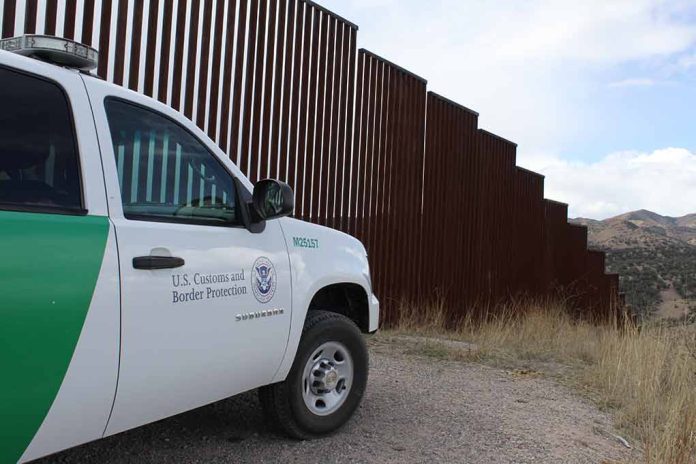
President Trump’s recent emergency declaration for the northern border has sparked a significant shift from traditional walls to cutting-edge surveillance technology as federal agents battle human smuggling and drug trafficking across the 4,000-mile U.S.-Canada frontier.
Key Takeaways
- President Trump has declared a state of emergency for the northern U.S.-Canada border due to increasing human smuggling and drug trafficking operations
- Border Patrol is prioritizing advanced technology solutions including drones, ground sensors, and specialized cameras over physical barriers along the 4,000-mile frontier
- Federal agents face significant challenges including harsh weather conditions, remote terrain, limited personnel, and unreliable communications infrastructure
- A significant number of individuals on the FBI’s terrorism watch list have been apprehended at the Canadian border, highlighting critical security concerns
- The White House is pursuing enhanced border security technologies through a pending budget reconciliation bill
Technology Over Traditional Walls
Unlike the southern border, the nearly 4,000-mile boundary with Canada presents unique challenges that make traditional wall solutions impractical in most areas. Border Patrol officials have increasingly turned to sophisticated surveillance equipment including aerial drones, ground sensors, infrared cameras, and long-range monitoring systems. These technologies enable agents to detect and respond to illegal crossings despite having fewer personnel stretched across vast wilderness areas and challenging terrain that includes dense forests, mountains, and numerous waterways.
“There are parts where, look, a wall isn’t going to stop people. What it does is slows them down so that the Border Protection can get time to get to people and find people that might actually be committing crimes or trafficking either people. It’s a little trickier with the weather conditions and also with these waterways” Stated Claudia Tenney.
In specific areas where vehicle smuggling has been problematic, Border Patrol has implemented targeted physical barriers such as cement blocks. However, the primary security strategy focuses on technological solutions tailored to the northern border’s unique characteristics. This approach allows for more effective monitoring without disrupting legitimate trade and travel between the United States and Canada, which remains America’s largest trading partner.
Innovative Surveillance Solutions
Border Patrol has deployed increasingly sophisticated and sometimes surprising surveillance technologies. Strategic placement of cameras on electrical poles and trees provides essential monitoring capabilities in key crossing areas. Perhaps most innovative are the “BuckEye” cameras, which are cleverly disguised as tree bark to blend seamlessly into the natural environment while providing crucial intelligence on illegal border activities. These camouflaged devices represent just one example of how border security has evolved beyond traditional barriers.
“As far as Americans having faith in what we’re doing, we are now using 3D printing machines. We’re printing fake trees that have cameras. There is some really cool stuff going on” Stated Raymond Bresnahan.
Despite these technological advances, Border Patrol agents face substantial challenges with constant monitoring requirements and environmental conditions that can damage or limit equipment effectiveness. Many surveillance systems require manual monitoring, stretching already limited personnel resources. Additionally, the northern border’s harsh climate presents serious durability concerns for sensitive electronic equipment, requiring specialized designs that can withstand extreme temperature variations and weather conditions.
Communication Challenges and National Security Concerns
Perhaps the most significant obstacle for northern border security operations is inadequate communication infrastructure in remote areas. Agents frequently operate in regions with limited or no cellular service, rendering some surveillance technologies ineffective without reliable data transmission capabilities. Border Patrol officials have identified critical needs for improved communication tools, including signal repeaters and satellite technology, to ensure agents can respond effectively to security threats in isolated locations.
“This technology also has to be developed in a way that they can withstand the harsh temperatures and the harsh environments that we see on the northern border” Stated Scott Good
The northern border security situation has taken on greater urgency with reports that a significant number of individuals on the FBI terrorism watch list have been apprehended attempting to enter through Canada. This alarming development has intensified cooperation between U.S. and Canadian authorities, with the Canadian government investing $1.3 billion in border security and immigration enforcement tools. Cross-border information sharing has become a critical component of efforts to identify and intercept potential terrorists before they can enter the United States.
Future Technology Needs
Looking ahead, Border Patrol officials have identified several key technological improvements needed to enhance northern border security. These include advanced systems capable of differentiating between animal and human movements to reduce false alarms, and “beyond line of sight” detection capabilities that can monitor larger areas with fewer devices. President Trump’s administration is pursuing funding for these enhanced technologies through a pending budget reconciliation bill aimed at strengthening America’s border security infrastructure.
The transition from physical barriers to high-tech surveillance along the northern border represents a strategic adaptation to unique geographical and operational challenges. By embracing technological solutions tailored to the specific needs of the U.S.-Canada boundary, Border Patrol aims to maximize security effectiveness while managing limited resources across one of the world’s longest international borders. As human smuggling, drug trafficking, and terrorism concerns persist, these technological investments will play an increasingly vital role in protecting America’s northern frontier.














